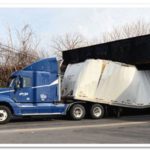Most heavy truck-passenger vehicle accidents are the fault of the passenger vehicle. 1 in 10 collisions in the United States involve a heavy-duty truck. A truck driver must know what to do in the event his/her truck is involved in a collision and filing a truck driver accident report form is one of the most important tasks. The way a truck driver responds to an accident can determine how the shipper, customer, law enforcement, and his/her carrier react. This article will outline the rules regarding post-accident procedures and provide a sample truck driver accident report form.
An accident report form is not the only thing you should be carrying, you should also have a HI-VIS vest, camera, and 3 reflective triangles.
Specialized Cargo
Specialized cargo or cargo carried on specialized trailers can determine the type of pre-and-post-accident procedures required to be completed. Cargo on flatbed trailers such as lumber can fall off after a collision which is why cargo securement is a high safety requirement. Tanker-trailers carrying hazardous materials are at risk of rupturing, spilling, and even causing an explosion. This is one of the reasons HAZMAT carriers are required to equip their trucks with a 10 lb. B:C fire extinguisher. Make sure you have a spill kit and an emergency response guidebook.
If you are carrying non-hazardous materials as your cargo you are still required to have a 5lb B:C fire extinguisher and mounted on your vehicle. It should be checked to ensure its in good working condition during the pre-trip inspection. Check to see the nozzle is clear, tip of the ring pin is in place, and the pressure gauge needle is in the green zone.
What should a truck driver accident report form include?
Documenting key information on a semi-truck accident can help avoid many problems that may arise later. For example, missing information may result in denied insurance claims, being the at-fault party due to lack of evidence, and other types of legal action. Here are the key features that should be included in a post-accident report form for truck accidents:
Vehicle, driver, and carrier information
- Name, address, phone number, date of birth, and license number (incl. expiration date/issuing state/province) of truck driver
- Name, address, phone number, NSC/DOT #, and insurance policy number of motor carrier
- Year, make, model, color, unit number, and plate numbers of the truck/trailer
Time and location
- Date, time, city, town, state/province, and street/highway
Other vehicles, drivers, and passengers involved in the accident
- Name, address, phone number, date of birth, license number (expiration date/issuing state/province), insurance policy number of the other driver(s)
- Name, address, phone number, NSC/DOT#, and insurance policy number of the other motor carrier (if applicable)
- Year, make, model, VIN number, unit numbers, plate numbers and issuing state/province, and color of the other vehicle
Diagram of the incident
Drawing a diagram of the incident is an activity many insurance companies ask drivers and witnesses involved in an accident to perform. Therefore, there must be an area on the report form to draw a sketch of the collision. Make a note if the vehicle was making a turn, backing up, skidding, stopped/parked, passing, going the wrong direction, lost control, or jackknifed. When drawing a sketch, illustrate the direction of travel, points of impact, traffic signals, street/highway location, and landmarks.
Driving status
When a professional truck driver is involved in a semi-truck accident, one of the main steps a law enforcement officer will take is review the driver’s logbook. Therefore, a post-accident report form must include information on the driver’s status at the time of the incident. It should include:
- Number of on-duty hours accumulated up until the time of incident
- Distance traveled on the current trip
- Were headlights on/off?
- Speed of truck
- Number of lanes on the street/highway and which lane your truck was traveling in.
- Warning signals such as brake lights/emergency lights/horns before the collision.
Road, traffic, and weather information
Road conditions must be noted in the report. For example, was the truck on the highway or parked at the loading dock? The grade, level, curve, and marking of the road should also be described. Terrain related information such as hills, cracks, gravel, potholes, and under construction should be described. Furthermore, was the road dry, wet, snow covered, icy, muddy, or oily? For example, if the collision occurs just after it begins to rain, the road conditions are likely oily, slippery, and wet.
Traffic conditions including level of congestion, traffic light status, yield signs, railway crossing, and posted speed limit. Presence of streetlights is also an important fact to note.
Weather conditions include clear, snow, rain, sleet, hail, fog, dust, sand, daylight, and nighttime.
Hazardous Material Information
If you are hauling HAZMAT materials and there is a spill, leak, or explosion. Document the following information:
- Was cargo or fuel involved?
- Quantity of cargo or fuel involved?
- Date and time
- Identity information of responders to the environmental danger.
Police information
- Were police contacted
- Did police arrive at scene?
- Name and badge of police officer(s)
- Police report number and contact information
- Name of persons arrested/charged at scene.
Tow Trucks
If a tow is required for your truck, make sure to include information on how much time was spent at the scene by the tower, the number of trucks used to make the tow, and name of the towing company.
Witnesses
It is generally the voluntary choice of any bystanders who witnessed the incident to provide their testimony. B The report can have a tear away section which can be handed to a witness to fill out. The section can ask the witness their name, license plate (if applicable), phone number, and description of what they witnessed.
Conclusion:
While a truck driver accident report form is a great supporting document that can help during police investigations and insurance claim decisions, having solid evidence is a necessary component. Therefore, it is suggested truck owners install the best dashboard camera they can find in their vehicles to have proof of fact.



